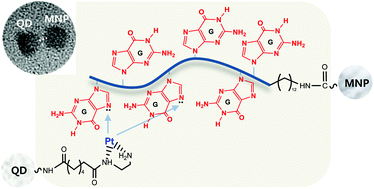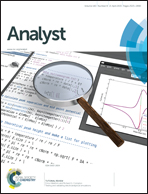One step synthesis of quantum dot–magnetic nanoparticle heterodimers for dual modal imaging applications†
Abstract
Dual modal nanoprobes are promising tools for accurately detecting target molecules as part of the diagnosis of diseases including cancers. We have explored a new dual modal bioimaging probe that is comprised of a quantum dot (QD)–magnetic nanoparticle (MNP) hybrid. The MNP–QD heterodimers explored are fabricated by using a platinum–guanine coordination bonding guided self-assembly process, employing the metal–DNA conjugation method. Investigations utilizing energy dispersive spectroscopy (EDS) equipped high resolution transmission electron microscopy (HRTEM) demonstrate that the heterodimer contains an iron (Fe) dominant MNP and a cadmium (Cd) dominant QD. Finally, the results of cell studies show that the MNP–QD conjugates display good HeLa cell uptake in the absence of non-specific binding to the cell membrane and, as such, they can be used to label cells in vitro and in vivo as part of a new cell imaging technique.


 Please wait while we load your content...
Please wait while we load your content...